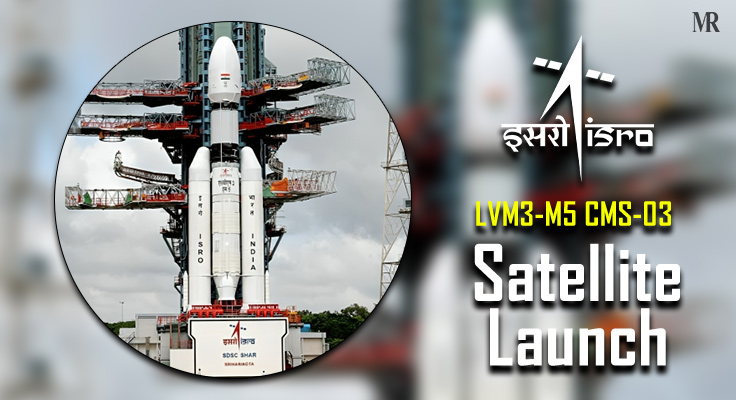Over the last few years, India’s space programme has rapidly improved. Where once smaller payloads and incremental launches were the norm, now we see heavy-lift rockets, multi-band satellites, and a growing ambition to shape not just national infrastructure but regional influence.
The recent ISRO Satellite Launch of CMS‑03 on the LVM3‑M5 (also known as the Bahubali Rocket) is the heaviest communication satellite launched from Indian soil, using a domestically built heavy-lift vehicle.
This signals India moving from “can launch” to “can launch heavy, strategic system reliably and domestically”.
In this blog, we’ll dig into
- What exactly CMS-03 and LVM3-M5 mean
- And 5 fascinating facts about the latest ISRO mission
These facts link defence & strategy, geopolitics, space tech, communications & civilian impact, and industry & economy.
What is the LVM3-M5 CMS-03 Mission?
To understand the LVM3 M5 CMS 03 purpose, let’s decode the terminology and mission first:
- LVM3-M5 meaning:
This is the launch vehicle (rocket) used for this mission. LVM3 (formerly GSLV Mk III) is ISRO’s heavy-lift workhorse capable of placing large satellites (~4000 kg) into Geosynchronous Transfer Orbit (GTO). The suffix “M5” indicates this is the fifth operational mission of this vehicle variant.
- CMS-03:
This is the satellite being launched by LVM3-M5. According to ISRO, CMS-03 weighs about ~4,400 kg and is described as a multi-band communication satellite that will serve the Indian landmass and wide oceanic regions. It’s also sometimes reported as GSAT-7R in media coverage (a naval-communications satellite designation).
Key Details of the Latest ISRO Satellite Launch
- LVM3 M5 launch date: The LVM3-M5 ISRO Satellite Launch took place on 2 November 2025 from the Satish Dhawan Space Centre, Sriharikota.
- Satellite weight: ~4,410 kg (making it the heaviest communication satellite launched from India to GTO).
- Destination: Geosynchronous Transfer Orbit (GTO), which is the first major step before reaching the final geostationary slot.
- Vehicle: LVM3-M5, the fifth operational flight of its series, reinforcing its reliability.
- Purpose: CMS-03 is designed to provide secure, high-capacity communication services for India’s landmass and wide ocean regions, supporting both national defence and essential civilian connectivity.
After the launch, Prime Minister Narendra Modi said the success of the CMS-03 “reflects the growing strength of India’s space capabilities and its commitment to national security”.
5 Fascinating Facts About the LVM3-M5 Communications Satellite
Now that we have understood what ISRO LVM3-M5 means, let’s look at five compelling facts about this ISRO Satellite Launch and what it really means across different sectors.
Fact 1: It Brings Strategic Communications Clout For Defence & Naval Capability
CMS-03 is not just another communications satellite (comsat). Reports identify it with the navy-communication series (GSAT-7R) and emphasise its role in strengthening maritime C2 (command & control) and secure links for the Indian Navy.
- Why this matters:
For a navy with surface ships, submarines, aircraft, and remote maritime zones, satellite links are critical. A multi-band communication satellite means bandwidth, resilience (anti-jamming, frequency diversity), and a wider footprint. By owning this capability, India reduces dependency on external or commercial links, thereby increasing strategic autonomy.
- Data insight:
At ~4,410 kg, this is one of the largest communication satellites India has placed via its own rocket. Larger payloads generally mean more transponders, more beams, or wider coverage, giving India a stronger layer.
- Forecast:
Within 2 years, we’ll likely see this satellite integrated into naval exercises, linked with surface assets, and possibly coalition operations (e.g., with friendly navies in the Indian Ocean Region).
Fact 2: It Alters the Power Balance in the Indian Ocean Region (IOR)
The satellite provides services over “wide oceanic regions including the Indian landmass”.
- Why this matters:
The IOR (Indian Ocean Region) is increasingly contested. China, other extra-regional navies, and maritime infrastructure (cables, islands) all play a role. A domestically-controlled satellite that can ensure secure communications for maritime assets gives India an edge.
- Data & precedent:
Previously, heavier satellites might have been launched abroad, or India might have been reliant on foreign launch services. As the Indian Express stated: “So far, ISRO had to contract out the launch of its heavier satellites,” but now it’s doing it in-house.
- Forecast:
India will likely use this comsat to expand its footprint in the IOR. For example, better coordination of Indian Ocean surveillance, humanitarian response, and logistics. It may also enable India to offer “satcom-as-service” to friendly navies, increasing its influence.
Fact 3: It Demonstrates India’s Heavy-Lift & Space Autonomy Maturing
The LVM3 vehicle has been evolving with better engines and greater capacity and now demonstrates it can launch heavier payloads, such as CMS-03.
- Why this matters:
Space autonomy is not only about launching but launching what you need, when you need it, from your own soil, with your own systems. By doing so, you reduce foreign dependency, open new domestic mission classes (defence, deep-space, crewed), and shape future architecture.
- Technical insight:
The LVM3 is capable of putting ~4,000 kg into GTO per specs. With CMS-03 at ~4,400 kg, this mission tests and validates the margins and maturity of the system.
- Forecast:
This ISRO satellite launch will accelerate plans for heavier satellites (5–6 t class) from India. Also, the next stage may see human-rating of LVM3 (for crewed flights under Gaganyaan) becoming more credible. Probability is high that this mission will be referenced in future ISRO roadmaps for heavy-lift, space station modules, or international commercial launches.
Fact 4: It Upgrades Communications & Civilian Resilience
Though defence is a major driver, CMS-03 is described as a “multi-band communication satellite” that will serve land and ocean regions.
- Why this matters:
A powerful communication satellite enhances civilian infrastructure: broadcasting, remote area connectivity, disaster response, maritime connectivity, remote education, and healthcare services in underserved locations (islands, deep-sea platforms).
- Insight & data:
Multi-band means possibly C-, Ku-, Ka-bands, etc, offering diverse services and redundancy. In regions vulnerable to natural disasters (cyclones, tsunamis), satellite links become a lifeline when terrestrial networks are down.
- Forecast:
Over the next 2–4 years, this satellite may underpin new public-private programmes for remote connectivity (Andaman & Nicobar, Lakshadweep), and the government may announce dedicated “satcom for disaster response” frameworks leveraging CMS-03.
Fact 5: It Energises India’s Space Economy and Industrial Base
Launching heavy, strategic satellites domestically signals confidence in manufacturing, supply chains, launch services, and associated industries.
- Why this matters:
To build a space economy, you need more than launches: you need satellite manufacturing, subsystem supply chains, integration, launch service infrastructure, and ground control systems. A mission like this ISRO Satellite Launch acts as a platform, a showcase, a proof-point.
- Industry insight:
The LVM3’s ecosphere (boosters, cryogenics, fairings) and satellite bus manufacturing are now under higher-stress labels. That means scale-up, quality improvement, and export potential.
- Forecast:
Within 3–5 years, India may export satellite manufacturing or launch services to friendly nations. Also, a new generation of Indian space startups may emerge around heavy-sat bus subsystems, in-orbit services, satellite analytics, etc.
Conclusion
The LVM3-M5/CMS-03 mission isn’t just another ISRO satellite launch; it’s a turning point for Indians.
From defence and naval communications, for India’s position in the Indian Ocean Region, for its space technology roadmap, for civilian connectivity, and for the economic-industrial base, this launch benefits all.
In a world where space is no longer a playground for a few but a contested domain of sovereignty, influence, and infrastructure, India’s ability to lift and operate such a satellite marks it as a credible player.
The true measure of this ISRO communications satellite won’t just be the launch itself, but how this asset is employed: the missions enabled, the partnerships forged, the capabilities matured.
If India plays its cards well, this mission could be remembered as the day when the country didn’t just watch space, but stepped into it as an architect of its own future.
FAQs
- Which is India’s most powerful rocket?
The LVM3 (full form) is India’s most powerful rocket. It is also called the Bahubali Rocket because it can lift heavy communication satellites into Geosynchronous Transfer Orbit and is the same launcher selected for India’s upcoming crewed space missions.
- Which is the heaviest satellite launched in India?
The GSAT-7R is the heaviest satellite launched in India. It weighs around 4,410 kg, making it the largest communication satellite ever placed into orbit from Indian soil.
- What is LVM3 full form?
LVM3 full form is Launch Vehicle Mark-3. It is a three-stage heavy-lift rocket developed by ISRO to carry large satellites to Geosynchronous Transfer Orbit and to support future human-spaceflight missions.











